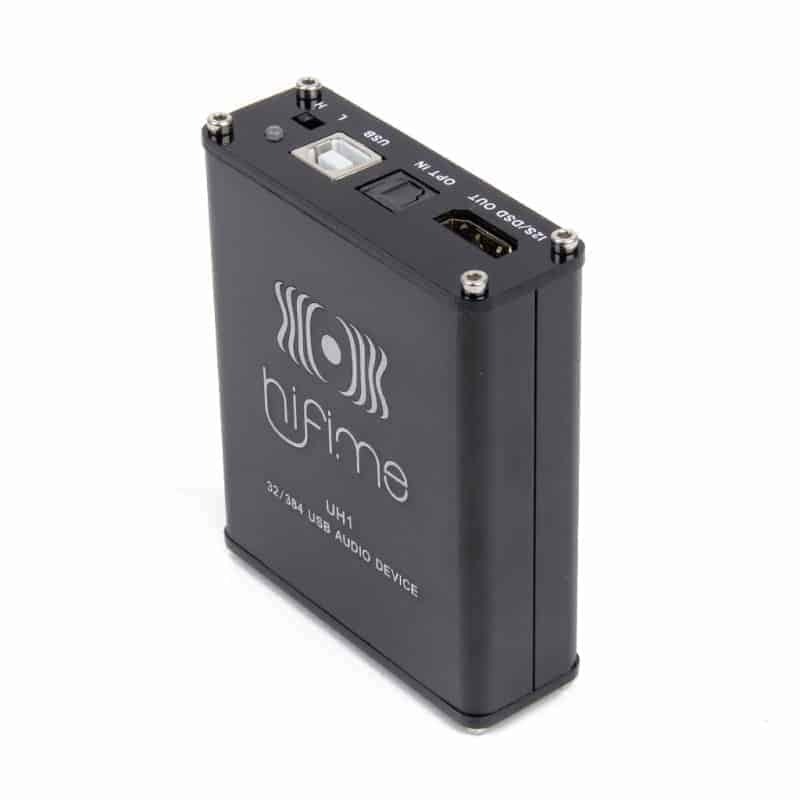Hifime UH1 manual
Introduction
Thanks for buying the Hifime UH1 DAC !

The UH1 DAC has the following specs:
- Asynchronous USB transfer with two TCXO as master clock
- Texas Instruments PCM5102 DAC chip, Savitech SA9227 USB receiver
- Two analog outputs: One direct from the DAC chip and one buffered by headphone amp (TPA6120A)
- Digital outputs: I2S, DSD, SPDIF/optical (DSD output from digital only, not analoge)
- Digital inputs: SPDIF (routed to USB only)
- Accepts all sample rates up to 384kHz/32bit
- No drivers required for Mac and Linux. Drivers available for Windows
- Asynchronous USB transfer
- USB powered
- Switchable USB modes (Full Speed / High speed) Full speed does not required Windows drivers
- Works with most headphones AND line level inputs (preamps and amps)
- Line output: 2.1Vrms
- Headphone output: 80mW/1.6Vrms max output to 32ohm load. 16mW rms/2Vrms to 250ohm loads
- Minimum headphone load : 16 ohm
- Dimensions: 85x70x24mm
Instructions
The UH1 is plug in play in Mac and Linux. Windows requires drivers to be installed prior to usage.
Mac OS X
With a Mac you might be running already, here is a guide on how to select the Hifime DAC as the output device:
See the guide for selecting the device as the output.
Windows
See this guide for installing Windows drivers.
See the guide for selecting the device as the output.
Additional feature: Digital Optical OUTPUT
There DAC does also output a optical SPDIF signal through the same 3.5mm output connector that are used for headphones. You can not use the SPDIF output on the same time as using headphones. The SPDIF signal comes directly fromt the USB receiver chip, the DAC chip is not used when outputting a digital SPDIF signal.
Additional feature: Digital optical INPUT
This DAC does also have a optical SPDIF input that routes a SPDIF input signal to your computer through USB.
Note that the optical SPDIF input goes to the computer only! It is not routed to the analoge output.
To use the digital input simply connect your optical SPDIF signal to the DAC and it will be sent to the computer. You will see the input in the computers input devices. Make sure to set the input sample and bit rate to the same as the source to avoid noises.
Additional feature: I2S output using HDMI port
DSD/I2S using HDMI port. Here is a linked drawing with the pinout for DSD and I2s.
This HDMI pinout is also used by several others, like PSAUDIO.
Note – this It not compatible with “normal” HDMI devices like a DVD player. The HDMI port is only used as a convenient connector and a way to send i2s balanced which improves signal quality. The DSD signal is also balanced. The pinout is made so that there is no harm done if you should connect it to a normal HDMI device.
Usage
High Speed / Full Speed switch
The UH1 has a switch to set USB Full Speed (12Mbps) or High Speed (480Mbps) mode. High Speed mode is needed by sample rates above 24/96 but requires drivers in Windows. If you set the switch to “Full Speed” mode it will run in USB Audio class 1 which means that you don’t have to install drivers in Windows. This feature can be convenient in some situations. On some versions “L” represents FS, and H represents High Speed.
General considerations and warnings
There is a couple of things you should be aware of when using the DAC.
1. Always disconnect headphones or turn off your amplifier before plugging/unplugging the DAC. This is because there might be a loud pop when connecting/disconnecting the DAC.
2. Check volume level before start playing when using headphones, as the level might be too loud, especially for sensitive headphones. The computer will generally remember the volume last used when you connect it to the same USB port.
For troubleshooting or support please visit this link:
Hope you’ll enjoy the DAC! And please consider spreading the word and write a review.
